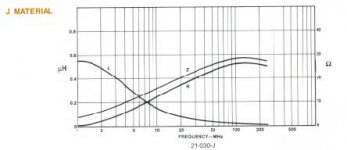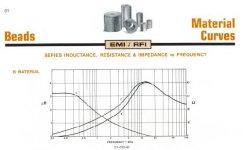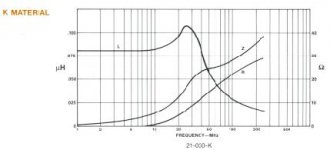No, beads do not work as inductors! The inductance is minimal.
Google up "ferrite beads", and read the data sheets by the guys who make them. I don't want to have to 'splain this again.
Or I will punish!
Jocko
Google up "ferrite beads", and read the data sheets by the guys who make them. I don't want to have to 'splain this again.
Or I will punish!
Jocko
Beads are inductors; put one on a LCR bridge with an extremely low test voltage or current and you'll see an inductance value. The datasheet probably has an inductance vs current curve too. They just happen to be extremely bad inductors which saturate under extremely low currents, and have an ungodly amount of core loss. So much that when you put any MHz signal through them their impedance is dominantely resistive.
They're incredibly useful because they dissipate EMI instead of radiating it or "bouncing it off a capacitor" in a typical LC filter, their low L avoids inductive flyback trouble with changing power supply loads, and they pick up very little EMI.
I recently had to call up and yell at a company because they decided to use unshielded drum inductors (Coilcraft DO33xx series) in a LC power supply filter in their product. Of course these inductors work great in a 'quiet' lab environment, but act like fantastic antennas when you place them near high power broadcast equipment - strange how PLLs fed by these LC filters seemed to find new reference frequencies! Don't do that.
They're incredibly useful because they dissipate EMI instead of radiating it or "bouncing it off a capacitor" in a typical LC filter, their low L avoids inductive flyback trouble with changing power supply loads, and they pick up very little EMI.
I recently had to call up and yell at a company because they decided to use unshielded drum inductors (Coilcraft DO33xx series) in a LC power supply filter in their product. Of course these inductors work great in a 'quiet' lab environment, but act like fantastic antennas when you place them near high power broadcast equipment - strange how PLLs fed by these LC filters seemed to find new reference frequencies! Don't do that.
1 bead per day

You must have 1 bead just before dinner to appreciate high-endJocko Homo said:No, beads do not work as inductors! The inductance is minimal.
Google up "ferrite beads", and read the data sheets by the guys who make them. I don't want to have to 'splain this again.
Or I will punish!
Jocko

Yes sort of. They have a reactive part (inductive) and a resistive but the inductance is hardly wL and the resistance is hardly R. Compare the graphs from Mr. Homo.gmarsh said:Beads are inductors
Oh, forget the sodding graphs........
"You can't say 'sodding' on the telly."
Think about how an "inductor" placed over an AC mains cable....both the hot and neutral........... can reduce EMI. I know lots of you have done that at one time.
Hmmm...............? Anyone other than Charles understand that?
Jocko
"You can't say 'sodding' on the telly."
Think about how an "inductor" placed over an AC mains cable....both the hot and neutral........... can reduce EMI. I know lots of you have done that at one time.
Hmmm...............? Anyone other than Charles understand that?
Jocko
Please don't punish us!!!!
 Please!!!
Please!!!


Are you talking about common mode or differential mode inductors?
I usually see common mode toroidal inductors in AC filters
....someone thinks the main filter is not effective at all 😕
what do you think about it?

 Please!!!
Please!!!


Are you talking about common mode or differential mode inductors?
I usually see common mode toroidal inductors in AC filters
....someone thinks the main filter is not effective at all 😕
what do you think about it?
What Jocko means is that if you put a wire through a bead you will get losses. HF energy is absorbed.
Mains filters are effective for certain signals, see the data for each filter. You must know the pros and cons for a filter if it is able to help you.
Mains filters are effective for certain signals, see the data for each filter. You must know the pros and cons for a filter if it is able to help you.
So....
If they are not inductors...
and they are not resistors...
and they are not capacitors....
What are they?
If they are not inductors...
and they are not resistors...
and they are not capacitors....
What are they?
They are a part which have two properties, an reactive part and one resistive part _but_ both those two components are unlinear and frequency dependent. The good thing is that they can absorb energy.
Poynton! You are right!😀 😀 😀 😀
...take four ferrite beads, put them into a big pot full of boiling evil-smelling liquid with a tail of lizard and two black spiders and....
....puff.....


...the digital noise has gone!!!!! 😱
It's the magic side of audio circuits!!!!😎
Hey! I'm jocking!

Good work to everybody!😉
...take four ferrite beads, put them into a big pot full of boiling evil-smelling liquid with a tail of lizard and two black spiders and....
....puff.....



...the digital noise has gone!!!!! 😱
It's the magic side of audio circuits!!!!😎
Hey! I'm jocking!


Good work to everybody!😉
What I am refering to is placing a bead over the AC mains cable to to your computer, or any other EMI making gizmo, so that you can watch TV or listen to the radio again. Yes, sometimes you have to use a toroid.........make several turns...........
The point is: an inductor could not remove noise by just being placed over the mains cable. Just because it does have some inductance is no reason to think of them as such.
Go read the sites of the guys who make them.........let them 'splain the technical mumbo-jumbo how they work.
Jocko
The point is: an inductor could not remove noise by just being placed over the mains cable. Just because it does have some inductance is no reason to think of them as such.
Go read the sites of the guys who make them.........let them 'splain the technical mumbo-jumbo how they work.
Jocko
poynton said:So....
If they are not inductors...
and they are not resistors...
and they are not capacitors....
What are they?
They are a resonance circuit with loss to dissipate energy in a certain freq area.
\Jens
They certainly behave like inductors when the higher frequency material beads with a couple of turns of wire are used in video filters and in rf amplifiers. The low frewuency materials have the useful property that they go very lossy before they go self resonant so they present a useful impedance and attenuation at high frequnecies
Uh.........the way around that is to stack them, not wrap a bunch of turns around one bead. Yeah, that is what happens when you take the easy way out. It usually bites you in the.........
Jocko
Jocko
OK so that Beads but what are EMI absorbers
as described here :
http://rswww.com/cgi-bin/bv/rswww/subRangeAction.do?catoid=-1600760652&cacheID=uknetscape
IN my old TDA1540 based CD player, the main SAA7000, 7010, 7020 chip set are decoupled wih 22uF caps + cermaic bypass and a 47uH choke in each supply. Would one of these EMI absorbers provide a better supply ?
as described here :
http://rswww.com/cgi-bin/bv/rswww/subRangeAction.do?catoid=-1600760652&cacheID=uknetscape
IN my old TDA1540 based CD player, the main SAA7000, 7010, 7020 chip set are decoupled wih 22uF caps + cermaic bypass and a 47uH choke in each supply. Would one of these EMI absorbers provide a better supply ?
- Status
- Not open for further replies.
- Home
- Source & Line
- Digital Source
- "Bead", what is that?




